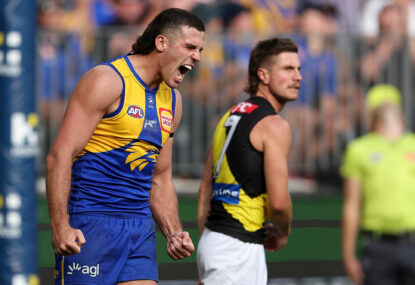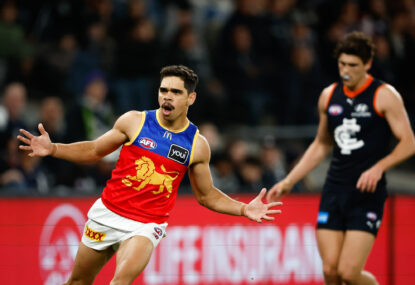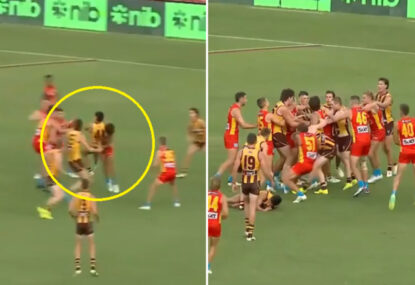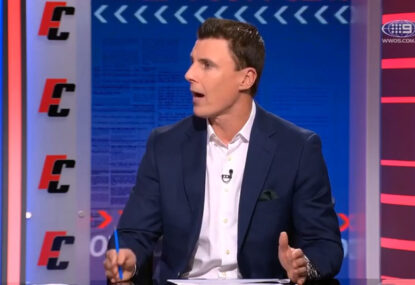An errant paddle of a ball over the boundary line, a dubious free kick and the last snatch at greatness for Fitzroy had faded.
If the footy gods had have acted with foresight in mind perhaps the result of the 1983 Qualifying Final would have been different and we would this week be celebrating 30 years since old Fitzroy played in a Grand Final.
A four-point loss to eventual Premiers Hawthorn in the Qualifying Final turned into a straight sets exit via Essendon in the first Semi Final.
Had the Lions been winners in that nail-biter they would have gone into a second Semi Final against top-placed North Melbourne.
Fitzroy had thumped North by 45 points in Round 2, and then humiliated them by 150 points in Round 13 and they were all that stood in the way of a Fitzroy Grand Final that would have been its first since 1944.
That 1983 team was the best of the Fitzroy teams that grasped for success through the 1980s that also included a Preliminary Final appearance in 1986 and finals appearances in 1981 and 1984.
30 years have passed and sadly Fitzroy was gone after 13 of them.
However the football stories of 2013 have had a distinct Fitzroy flavour of the era, even if the connection has not been made since we are so far removed from this time.
Arguably the three most talked about coaches of 2013 that didn’t have connections to supplement regimes are products of 1980s Fitzroy.
The most sought-after coach in football (Paul Roos), the coach presiding over the fairytale rise of the season (Ken Hinkley) and the coach that takes his team into a grand final and is widely acknowledged as the coach that has the greatest influence on his team (Ross Lyon), all started their elite football lives at Fitzroy in the 1980s.
The Swans also have a continued Fitzroy connection post-Roos with assistant coach John Blakey.
But it’s not just coaching where Fitzroy makes it mark. No less than three club CEOs played in Fitzroy teams of the 1980s.
Gary Pert at Collingwood, Keith Thomas at Port Adelaide and Michael Nettlefold at St Kilda (who had the aforementioned deliberate out of bounds paid against him in 1983).
But it doesn’t stop there, Fitzroy cult hero Mick Conlan is CEO of AFL Queensland and was linked with a role at the Brisbane Lions recently.
Scott Clayton is one of the most respected football operators in the country and is responsible for assembling the talent-laden Gold Coast Suns as List Manager, and played at Fitzroy.
A Fitzroy captain, Matt Rendell has bounced back from the controversy of 2012 to pick up a recruiting role at Collingwood.
Leon Harris is a Development Manager for AFL Victoria, Tony Woods looks after the international expansion of the game at the AFL and Alastair Lynch is a player manager and Fox Footy analyst.
All played at Fitzroy in the 1980s, but it’s not just the players.
Fitzroy’s coaches during the 1980s, Robert Walls, David Parkin and Rod Austin have all had continued influence in footy, Walls and Parkin via subsequent coaching and media and Austin through a long-time role at AFL HQ in footy operations.
For a club that went out of existence in its known form in 1996, it seems to be an inordinate influence given it wasn’t winning Premierships.
Contrast Hawthorn during this time and the life-long gravitas Premiership success gives to its players that sets up media and other football related post-playing careers.
It may be mere coincidence, but much like North Melbourne players of the 90s talk about the lack of facilities and ‘shinboner spirit’
there seems to have been an element of resourcefulness at Fitzroy that has carried on through its alumni.
There was no question that Fitzroy in the 1980s was the club without a home (three different home grounds during the 1980s), with a dwindling supporter base, and without a dollar.
The poorest of all the poor cousins of the VFL.
They were fighting losing battles on three fronts, and it took significant and creative coaching efforts and innovative recruiting (think the rise of Mark Dwyer from Koroit Seniors to 10 Brownlow votes all during the 1986 season) to keep the team competitive on the field while the wolves were kept form the door off-field.
Did the extra dimension foisted upon Fitzroy players of the 1980s give them a different outlook on the game, a more rounded education with a football club flying by the seat of its pants on all fronts.
Walls once fired at Kevin Sheedy about not having the full footy experience , spending his career at successful clubs while Walls pioneered in Brisbane as well as his time at Fitzroy.
Being a Fitzroy player during this time must have been one of the most turbulent atmospheres that a player could ever fall into with the constant talk of financial solvency, relocation, mergers.
In a weird way this turbulence may have given these ‘Roy Boys’ a slice of the resourcefulness among football chaos along with their own drive, hard work and talent that has elevated them above the pack in the industry.
It could be argued that the Fitzroy influence in 2013 is greater now than it has ever been since their 1996 demise.


































































































